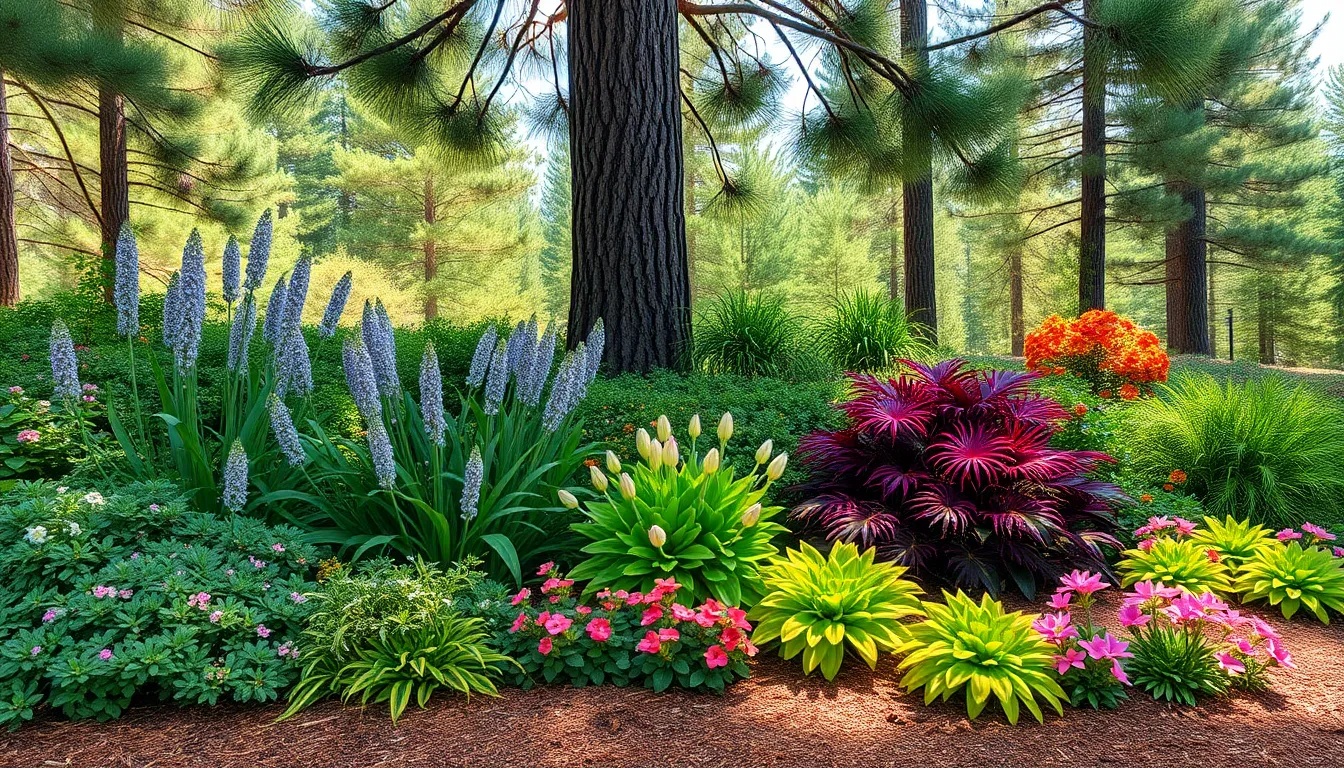Picture this: a serene oasis of greenery nestled beneath towering pine trees, where the gentle rustle of needles creates a natural symphony. Landscaping under these majestic giants isn’t just a challenge; it’s an opportunity to showcase creativity and resilience. While many shy away from the shade and acidity of pine needles, savvy gardeners know that with the right approach, they can transform this often-overlooked space into a lush haven.
Landscaping Under Pine Trees
Landscaping under pine trees presents unique opportunities for creativity while addressing some specific challenges. Understanding the benefits and challenges helps gardeners navigate this environment effectively.
Benefits of Pine Trees in Landscaping
Pine trees provide effective shade, reducing heat and protecting plants from extreme sunlight. Their needles not only add aesthetic appeal but also act as a natural mulch, enriching soil quality over time. A diverse range of understory plants thrives in cooler, shaded environments, while the pine’s root system can stabilize soil and prevent erosion. Wildlife benefits from these trees, as they create habitat for birds and beneficial insects, enriching the local ecosystem.
Challenges of Landscaping Under Pine Trees
Landscapes beneath pine trees often experience high acidity, affecting soil composition and plant growth. Limited light penetration reduces plant options, making it difficult to achieve vibrant landscapes. Additionally, falling pine needles create maintenance needs, requiring regular cleaning to prevent build-up. Competition for nutrients arises from the extensive root systems of pine trees, making plant selection and placement crucial for success in these areas.
Best Plants for Landscaping Under Pine Trees

Landscaping under pine trees presents unique opportunities for plant selection. Specific plants succeed in shaded, acidic environments, thriving amidst the challenges posed by the pine tree ecosystem.
Shade-Tolerant Ground Covers
Creeping thyme excels in low-light conditions, creating dense mats and enhancing soil stability. Additionally, golden creeper offers vibrant foliage, maintaining color throughout the seasons. Mondo grass stands out for its resilience and attractive, grassy texture. Each of these ground covers proves effective for controlling erosion while adding visual interest to shaded areas.
Perennials for Pine Tree Areas
Lungwort brings striking foliage and lovely blooms, thriving in acidic soil under pine trees. Another great choice, hostas, offers rich variety and resilience in shaded spaces. Astilbe contributes feathery flowers and lush leaves, providing height differentials in the landscape. This combination of perennials flourishes while drawing attention away from the challenges of the pine environment.
Shrubs that Thrive in Pine Needle Mulch
Azaleas adapt well to the acidic conditions created by pine needles, presenting breathtaking blooms annually. Blueberries serve as dual-purpose shrubs, offering ornamental beauty and delicious fruit. Additionally, evergreen varieties like rhododendrons maintain year-round interest and structure. Selecting these shrubs fosters a unique blend of color and texture in the pine-studded landscape.
Design Ideas for Landscaping Under Pine Trees
Landscaping under pine trees offers unique opportunities for creativity. Designing these spaces requires consideration of both aesthetics and the specific conditions created by the trees.
Creating a Natural Look
Select plants that mimic the forest floor for a harmonious appearance. Use native ferns and wildflowers to enhance the natural feel of the area. Grouping these plants in clusters creates depth and visual interest. Mulching with pine needles not only improves soil but provides a cohesive look. Incorporating boulders or natural stones can further enhance the rustic charm of the landscape.
Implementing Garden Paths
Paths made of gravel or stepping stones can guide visitors through the shaded garden. Choose materials that blend with the natural environment for a seamless transition. Position paths to navigate around larger trees, ensuring they don’t disrupt root systems. Wide paths maintain accessibility while inviting exploration. Use low-growing ground covers alongside paths for added texture and color.
Adding Decorative Features
Incorporate decorative elements that suit the serene environment. Bird feeders can attract wildlife, adding movement and sound to the landscape. Sculptures or garden art provide focal points among the greenery. For functional features, consider benches for seating that blend with the landscape. Wind chimes can introduce gentle sounds, enhancing the peaceful atmosphere created by the pine trees.
Maintenance Tips for Landscapes Under Pine Trees
Landscaping under pine trees requires specific maintenance strategies to ensure the area thrives. These techniques help manage acidity, support plant health, and create a vibrant environment.
Soil Improvement Techniques
Soil quality plays a crucial role in plant growth. Adding organic matter, such as compost or well-rotted leaf mulch, enhances nutrient levels. Analyzing soil pH also proves essential, as optimal ranges support plant vitality. Incorporating lime can neutralize acidity, creating a more balanced environment for various plants. Additionally, mixing in earthworms promotes aeration, easing root penetration and nutrient absorption.
Watering and Mulching Strategies
Effective watering practices maintain moisture without over-saturating roots. Drip irrigation systems deliver consistent water directly to plants’ bases, minimizing waste. Adjusting watering frequency based on seasonal changes is also necessary, as pine trees create unique moisture dynamics. Applying a thick layer of organic mulch around plants retains moisture and suppresses weed growth. Pine needles can serve as a biodegradable mulch, gradually enriching soil as they decompose. Such strategies ensure lush growth and a thriving landscape beneath the pines.
Conclusion
Landscaping under pine trees can transform challenging conditions into stunning outdoor spaces. With careful plant selection and thoughtful design, these shaded areas can thrive. Embracing the unique characteristics of pine trees allows for creative landscaping that enhances both beauty and functionality.
By choosing the right plants and incorporating decorative elements, gardeners can create inviting retreats that celebrate nature. Regular maintenance and soil improvement will ensure these landscapes remain vibrant and healthy. Ultimately, with the right approach, the area beneath pine trees can become a cherished part of any garden.

